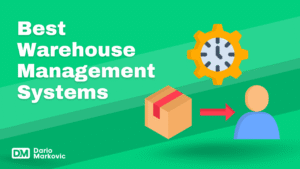Let's See How Can You Start an Online Tech Store
How to start an online tech store?
Starting an online tech store can be pocket-filling, but it does take some careful planning. I remember when I first thought about doing it, I was both thrilled and a bit overwhelmed. I had some descent hits in business so far, and I felt ready for my next endeavor. There are so many moving parts, from choosing and writing tech product descriptions to setting up a user-friendly website.
But don’t worry, I’ll help you out with this.
In this guide, I’ll share the key steps to help you get your online tech store up and running smoothly. I’ll also sprinkle in some of my own experiences and tips that I wish I had known when I started. So, grab a cup of coffee, get comfortable, and let’s dive into the world of online tech retail together.
By the end of this, you’ll have a clear roadmap to follow and the confidence to start and choose the best online platform for your tech store.
Let’s get started!
Key Takeaways from Starting an Online Tech Store
Market Research and Planning: Understand the importance of researching your market, choosing the right products, and creating a solid business plan to set a strong foundation for your online tech store.
Setting Up and Managing Your Store: Learn the steps to build and launch your online store, including selecting an e-commerce platform, sourcing products, and implementing secure payment options.
Overcoming Challenges and Growing Your Business: Discover strategies to tackle common challenges, and understand the benefits of excellent customer service to build trust and loyalty.
What Are the Key Steps on How to Start an Online Tech Store?
Starting an online tech store involves several critical steps.
Each step is designed to help you build a strong foundation for your business.
1. Research Your Market
Understanding the market is crucial when starting an online tech store. We suggest you work with a dedicated B2B digital marketing agency to research the latest trends, identify your target audience, and analyze your competitors.
This will help you find a niche and understand what products are in demand.
2. Choose Your Products
Selecting the right products is vital. Focus on smart tech gadgets and accessories that are popular and have a high demand. Consider offering a mix of products, from high-end gadgets to affordable accessories, to cater to a broader audience.
3. Create a Business Plan
A solid business plan is essential for any successful business. Outline your business goals, target market, marketing strategies, and financial projections. This plan will serve as a roadmap for your online tech store.
4. Set Up Your Online Store
Choose the best e-commerce platform that suits your needs.
Platforms like Shopify, WooCommerce, and BigCommerce offer various features to help you set up and manage your online store. Ensure your website is user-friendly, mobile-responsive, and secure.
5. Source Your Products
You can find reliable suppliers for your tech products. You can source products from wholesalers, manufacturers, or even consider good dropshipping suppliers. Ensure that your suppliers offer quality products and timely delivery.
6. Implement Secure Payment Options
Offering secure payment options is crucial for building trust with your customers. For example, on Shopify you can integrate payment gateways like PayPal, Stripe, or Square to provide a seamless and secure checkout experience.
7. Market Your Online Store
Effective marketing is key to attracting customers to your online tech store.
Social media can shape customer experience, email marketing, and search engine optimization (SEO) to reach your target audience. Consider running promotions and discounts to drive sales.
8. Provide Excellent Customer Service
Customer service can make or break your online tech store. Offer prompt and helpful support to your customers. Address their queries and concerns quickly to build a loyal customer base.

Statistics About Online Tech Stores
Understanding the market niches and trending products plus statistics is crucial for anyone looking to start an online tech store.
Here’s an extensive look at the most relevant data and insights:
a. Global E-commerce Statistics
- Global E-commerce Sales: In 2024, global e-commerce sales are projected to exceed $6.3 trillion. This figure is expected to continue rising, reaching over $7.9 trillion by 2027.
- E-commerce Growth: The e-commerce sector is growing at an impressive rate, with an annual growth rate of 8.8% expected in 2024.
- Internet Users: As of 2024, there are over five billion internet users worldwide, contributing to the increasing number of online shoppers.
b. U.S. E-commerce Statistics
- Online Shoppers: In the U.S., there were over 268 million online shoppers in 2022, representing almost 80% of the population.
- Consumer Electronics: Nearly 50% of U.S. consumers search for information online before purchasing tech products.
- Revenue Projections: Revenue in the U.S. e-commerce market is forecast to reach $3.58 trillion in 2023 and $5.47 trillion by 2027.
c. E-commerce by Region
- China: In 2022, China had the highest e-commerce sales share at 56%.
- South Korea: South Korea followed with 32%.
- United Kingdom: The UK had a 29% share.
- Denmark and Norway: Denmark and Norway had 20% and 18% shares, respectively.
d. Consumer Behavior
- Mobile Shopping: The largest cohort of American online mobile shoppers is aged 18-24, making up 46.9%.
- Product Categories: Consumer electronics rank among the top items most purchased online as of June 2023.
- Average Spending: In 2015, the average global online purchase value was about $1,060. By 2021, this figure had increased to $2,310.
e. E-commerce Platforms and Marketplaces
- Leading Platforms: Shopify, WooCommerce, and BigCommerce are among the top e-commerce platforms used by online tech stores.
- Market Cap: Leading online marketplaces like Amazon and Alibaba have significant market caps, reflecting their dominance in the e-commerce sector.
f. Additional Insights
- Number of E-commerce Sites: There are an estimated 12 to 24 million e-commerce sites worldwide, with 2.5 million based in the U.S…
- Growth in Digital Shoppers: Over the past five years, the number of digital shoppers has increased by 40%, with sales volumes growing by 218%.
- Advertising Channels: The most popular advertising channels for online stores are Google Shopping, Facebook Ads, Amazon, and Google Search.
Key Takeaways
- Global Reach: The e-commerce market is vast and growing, offering significant opportunities for online tech stores.
- Consumer Behavior: Understanding consumer behavior, such as the preference for mobile shopping and the importance of online research before purchasing, can help tailor marketing strategies.
- Platform Selection: Choosing the right e-commerce platform is crucial for the success of your online tech store.
These statistics highlight the immense potential and growth of the e-commerce market, especially for online tech stores. If you need more detailed insights or specific data, feel free to ask!
Essential Tools for Your Online Tech Store
Having the right ecommerce business tools can streamline your operations and enhance your store’s performance.
Here are some essential tools:
- E-commerce Platform: Choose a platform like Shopify, WooCommerce, or BigCommerce.
- Payment Gateway: Integrate secure payment options like PayPal, Stripe, or Square.
- Inventory Management: Use tools like TradeGecko or Zoho Inventory to manage and improve your stock.
- Marketing Tools: Utilize tools like Mailchimp for email marketing and Hootsuite for social media management.
- Customer Support: Implement live chat support with tools like Zendesk or LiveChat.
What is Launching an Online Tech Store?
Launching an online tech store like Shopify involves creating a platform where customers can easily browse, select and purchase tech products.
Here’s a step-by-step guide to help you successfully launch your online tech store:
1. Define Your Brand
Start by building a strong brand identity that reflects the values and interests of your target audience. Choose a distinctive name, design an eye-catching logo, and establish a brand voice with one of the best Shopify themes that communicates trust and expertise.
2. Build Your Website
Create a user-friendly, visually appealing Shopify website that represents your brand. Ensure it’s mobile-responsive and SEO-optimized to attract organic traffic. A smooth and intuitive shopping experience will keep customers engaged.
3. Add Products
Populate your store with tech products, including detailed descriptions, high-quality tech product images, and competitive prices. Highlight key features and benefits to help customers make informed purchasing decisions.
4. Set Up Payment and Shipping
Integrate secure Shopify payment gateways and set up shipping options. Offer multiple payment methods and reliable shipping services.
5. Test Your Website
Before launching, thoroughly test your website for any issues. Check the functionality of all features, including the checkout process and payment gateways.
6. Launch and Promote
Once everything is set, launch your online tech store. Promote it through social media, email marketing, and other channels to attract customers.
What Are the Benefits of Starting an Online Tech Store?
Starting an online tech store offers several benefits:
- Wide Reach: An online store allows you to reach customers globally.
- Lower Overheads: Operating online reduces the need for physical retail space, lowering overhead costs.
- Flexibility: You can manage your store from anywhere, offering flexibility in your work schedule.
- Scalability: An online store can easily scale as your business grows, allowing you to add more products and reach more customers.
Insights from Real-Life Experiences
When I first decided to start my online tech store, I knew it would be a challenging yet rewarding journey. I spent countless hours reading through forums and Reddit threads, gathering insights from others who had walked the same path. One story that particularly resonated with me was from an entrepreneur who had initially ventured into dropshipping.
He started his dropshipping business with high hopes, attracted by the low upfront costs and the promise of easy profits. However, he quickly encountered issues with long shipping times and inconsistent product quality. Customers were frustrated, and he realized that relying solely on dropshipping wasn’t sustainable. This experience taught him the importance of having control over inventory and shipping processes.
Another entrepreneur shared how they focused heavily on the aesthetics of their website. They spent weeks perfecting the design, ensuring it looked stunning on desktop. But when they launched, they discovered that the majority of their traffic came from mobile devices. This oversight required them to go back and optimize their Shopify site for mobile, highlighting the importance of a mobile-first approach in today’s market.
A third story came from a business owner who initially offered a wide range of profitable ecommerce business ideas. He struggled to compete with larger retailers and found it difficult to establish a unique selling proposition. After some reflection, he decided to narrow his focus to a specific niche: smart home automation gadgets. This specialization allowed him to become an expert in his field and provide valuable insights to his customers, which significantly boosted his business.
Drawing from these experiences, I decided to take a balanced approach. I chose to maintain a small inventory of high-demand smart home tech gadgets and accessories, ensuring I had control over quality and shipping. I also made sure my website was optimized for both desktop and mobile users from the start. Most importantly, I found my niche in smart home devices, which allowed me to offer specialized knowledge and build a loyal customer base.
Starting an online tech store was undoubtedly a learning curve, but by leveraging the experiences of others, I was able to navigate the challenges and build a successful business. If you’re considering starting your own store, remember that it’s okay to make mistakes and learn from them.
Stay adaptable, and you’ll find your path to success.
Common Challenges and How to Overcome Them
Starting an online tech store comes with its challenges.
Here are some common challenges and how to overcome them:
- Competition: The online tech market is highly competitive. Differentiate your store by finding best winning and unique products.
- Logistics: Managing inventory and shipping can be complex. Use best inventory management software and partner with trustworthy shipping providers.
- Customer Trust: Building trust with customers is crucial. Offer secure payment options, transparent policies, and responsive customer support with one of these customer support apps.
My Personal Experience
Starting my online tech store was a journey filled with learning and growth. I faced challenges, from finding reliable suppliers to managing inventory. However, the satisfaction of seeing my store grow and receiving positive feedback from customers made it all worthwhile.
One of the key lessons I learned was the importance of customer service. Providing prompt and helpful support not only resolved issues but also built trust and loyalty among my customers. Additionally, staying updated with the latest tech trends helped me offer products that were in demand, driving sales and growth.
Starting an online tech store requires dedication and effort, but with the right strategies and tools, it can be a successful and rewarding venture. If you’re passionate about tech and ready to take the plunge, now is the perfect time to start your online tech store.
FAQ
What are the initial steps to start an online tech store?
To start an online tech store, begin with market research to understand your target audience and competitors. Choose your products, create a business plan, and select an e-commerce platform to set up your store.
How important is customer service for an online tech store?
Customer service is crucial for building trust and loyalty. Offer prompt and helpful support to address customer queries and concerns quickly.
How do I choose the right products for my tech store?
Focus on tech gadgets and accessories that are in high demand. Research market trends and consider offering a mix of high-end and affordable products to cater to a broader audience.
What E-commerce platforms are best for an online tech store?
Popular e-commerce platforms include Shopify, WooCommerce, and BigCommerce. These platforms offer various features to help you set up and manage your online store efficiently.
What payment options should I offer on my online tech store?
Integrate secure payment gateways like PayPal, Stripe, or Square. Offering multiple payment methods can enhance the customer experience and build trust.



